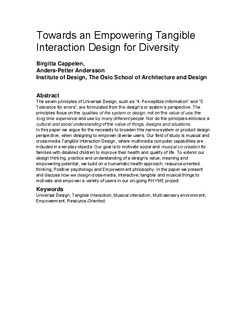Towards an empowering tangible interaction design for diversity
Chapter
Permanent lenke
http://hdl.handle.net/11250/93017Utgivelsesdato
2013Metadata
Vis full innførselSamlinger
Originalversjon
Myerson, Jeremy [Eds.] Include Asia 2013 Proceedings. Global Challenges and Local Solutions in Inclusive Design, Conference on Inclusive Design, The Helen Hamlyn Centre for Design at the Royal College of Art in London, the School of Design at the Hong Kong Polytechnic University and Hong Kong Design Centre, 2013Sammendrag
The seven principles of Universal Design, such as ”4. Perceptible Information” and ”5. Tolerance for errors”, are formulated from the design’s or system’s perspective. The
principles focus on the qualities of the system or design, not on the value of use, the long time experience and use by
many different people. Nor do the principles embrace a cultural and social understanding of the value of things, designs and situations. In this paper we argue for the necessity to broaden this narrow system or product design
perspective, when designing to empower diverse users. Our field of study is musical and cross-media Tangible Interaction Design, where multimedia computer capabilities are included in everyday objects. Our goal is to motivate social and musical co-creation for families with disabled children to improve their health and quality of life. To extend our design thinking, practice and understanding of a design’s value, meaning and empowering potential, we build on a humanistic health approach, resource-oriented thinking, Positive psychology and Empowerment philosophy. In the paper we present and discuss how we design cross-media, interactive, tangible and musical things to motivate and empower a variety of users in our on-going RHYME project.
